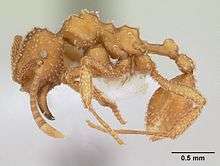Myrmicocrypta
Myrmicocrypta is a Neotropical genus of fungus-growing ants in the subfamily Myrmicinae. The genus is known from Mexico to Argentina. Their colonies are generally small, consisting of fewer than 200 individuals.[3]
| Myrmicocrypta | |
|---|---|
 | |
| Myrmicocrypta squamosa | |
| Scientific classification | |
| Kingdom: | |
| Phylum: | |
| Class: | |
| Order: | |
| Family: | |
| Subfamily: | |
| Tribe: | |
| Genus: | Myrmicocrypta Smith, 1860 |
| Type species | |
| Myrmicocrypta squamosa[1] | |
| Diversity[2] | |
| 27 species | |
Species
- Myrmicocrypta boliviana Weber, 1938
- Myrmicocrypta bruchi Santschi, 1936
- Myrmicocrypta buenzlii Borgmeier, 1934
- Myrmicocrypta collaris Emery, 1913
- Myrmicocrypta dilacerata (Forel, 1885)
- Myrmicocrypta ednaella Mann, 1922
- Myrmicocrypta elisabethae Weber, 1937
- Myrmicocrypta foreli Mann, 1916
- Myrmicocrypta godmani Forel, 1899
- Myrmicocrypta guianensis Weber, 1937
- Myrmicocrypta infuscata Weber, 1946
- Myrmicocrypta longinoda Weber, 1938
- Myrmicocrypta microphthalma Borgmeier, 1948
- Myrmicocrypta occipitalis Weber, 1938
- Myrmicocrypta ogloblini Santschi, 1936
- Myrmicocrypta rudiscapa Emery, 1913
- Myrmicocrypta spinosa Weber, 1937
- Myrmicocrypta squamosa Smith, 1860
- Myrmicocrypta subnitida Forel, 1899
- Myrmicocrypta triangulata Forel, 1912
- Myrmicocrypta tuberculata Weber, 1938
- Myrmicocrypta unidentata Weber, 1937
- Myrmicocrypta urichi Weber, 1937
- Myrmicocrypta weyrauchi Borgmeier, 1948
gollark: Not all religions say "be peaceful and not mean to each other", though?
gollark: I mean, if you believe Religion 1 and believe that everyone who believes Religion 2 will go to hell and suffer forever, then you obviously don't want Religion 2 to spread.
gollark: They're pretty rational if you actually believe your religion is true, though.
gollark: Looking at religious conflicts probably doesn't require knowing about all the deep details of the religions involved, because people do tribalism and probably do not meaningfully care about the actual underlying point.
gollark: You can just study history, though.
References
- "Genus: Myrmicocrypta". antweb.org. AntWeb. Retrieved 13 October 2013.
- Bolton, B. (2014). "Myrmicocrypta". AntCat. Retrieved 3 July 2014.
- Sosa-Calvo, J.; Schultz, T. R. (2010). "Three remarkable new fungus-growing ant species of the genus Myrmicocrypta (Hymenoptera: Formicidae), with a reassessment of the characters that define the genus and its position within the Attini". Annals of the Entomological Society of America. 103: 181–195. doi:10.1603/an09108.
This article is issued from Wikipedia. The text is licensed under Creative Commons - Attribution - Sharealike. Additional terms may apply for the media files.